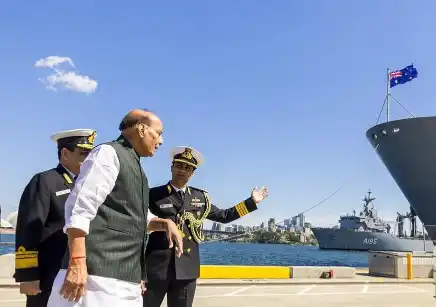India’s defence engagement with Australia reached a new level during Defence Minister Rajnath Singh’s recent visit to Canberra and Sydney for the first Australia-India Defence Ministers’ Dialogue. The visit, marking the first by an Indian Defence Minister to Australia in over a decade, resulted in several agreements that advance the relationship from strategic alignment to practical operational cooperation.

Key outcomes include a Joint Maritime Security Collaboration Roadmap to enhance naval cooperation, renewal of the Joint Declaration on Defence and Security Cooperation, and agreements on annual Defence Ministers’ Dialogues. Additional arrangements cover mutual submarine rescue support, progress on the air-to-air refuelling framework signed in 2024, expanded information-sharing, and the establishment of Joint Staff Talks to coordinate exercises, operations, and interoperability across domains.
Deepening Operational and Industrial Ties
These agreements reflect more than diplomatic signalling—they are operational and industrial in nature. Submarine-rescue arrangements and Joint Staff Talks enable coordinated responses and contingency planning at sea. Air-to-air refuelling and enhanced interoperability commitments extend tactical reach for joint air operations. Defence-industry roundtables and offers from Indian shipyards to support Australian fleet maintenance demonstrate a logistics- and sustainment-oriented partnership. These steps lay the foundation for more routine collaboration across the Indian Ocean and western Pacific.
The India-Australia defence relationship has evolved through three phases: strategic convergence, deepening operational ties, and industrial-logistics collaboration. Shared concerns over China’s assertive behaviour and support for a rules-based Indo-Pacific initially drove diplomatic alignment. Over time, growing exercise participation, information-sharing, and logistical cooperation created the groundwork for formal mechanisms such as air refuelling, exercises like Talisman Sabre, and the Joint Staff Talks.
Strategic and Practical Drivers
Structural factors, like shifting maritime power and Beijing’s coercive actions, have encouraged middle powers to reduce operational gaps. Practically, uncertainties about reliance on single security providers motivated India and Australia to enhance bilateral mechanisms, including logistics, rescue support, and defence industrial collaboration. Developments in AUKUS and Australia’s access to advanced platforms further increased the need for interoperability, which India can support with its shipbuilding and repair capabilities.
India’s strengths—scale, maritime geography, and growing domain awareness—complement Australia’s advanced technologies, including P-8A Poseidon aircraft, MQ-4C Triton drones, and autonomous submarines like Ghost Shark. India’s defence production reached ₹1.5 lakh crore in FY 2024-25, reflecting initiatives like Make in India and iDEX, creating a cost-effective, innovation-driven ecosystem. Together, these capabilities form a resilient, mutually reinforcing partnership that supports co-development, sustained operations, and a stable Indo-Pacific maritime order.
Political and Strategic Significance
The defence relationship, elevated to a Strategic Partnership in 2009 and a Comprehensive Strategic Partnership in 2020, builds on shared democratic values, growing economic ties, and people-to-people links. For Canberra, closer ties with New Delhi diversify security partnerships in the Indo-Pacific. For New Delhi, Australia enhances India’s reach in the southern Indo-Pacific while strengthening maritime domain awareness and industrial collaboration. Institutional mechanisms such as annual ministerial dialogues and Joint Staff Talks ensure continuity across political cycles.
Looking Ahead
While the agreements are incremental and reversible, they focus on interoperability and crisis management rather than binding security guarantees. Key areas to watch include the pace of implementing logistics and ship-repair arrangements, depth of classified information-sharing, joint defence-industrial projects, and alignment with broader Quad initiatives. If executed steadily, these measures will make India-Australia defence cooperation more routine, operationally meaningful, and strategically significant for Indo-Pacific maritime stability.
